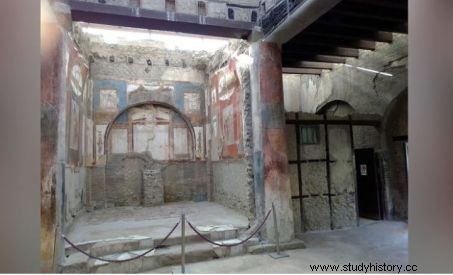The analysis of a vitrified brain fragment found among the remains of a young man who died during the eruption of Vesuvius (1 st century AD) reveals the presence of brain cells.

Section of vitrified brain tissue from the skull of a young man who died in Herculaneum during the eruption of Vesuvius in 79 CE.
Dead 2,000 years ago, but not reduced to dust! The brain cells of a young man in his twenties, who died 2,000 years ago, were found intact by a team of scientists at the site of Herculaneum (Italy).
An exceptional announcement
The unfortunate man died during the eruption of Vesuvius, the catastrophe that caused the destruction of the cities of Pompeii and Herculaneum in 79 AD. Featured in the American magazine Plos One, this exceptional announcement follows a first article published in January 2020 in the New England Journal of Medicine and which revealed the discovery in 2018 of a fragment of brain literally vitrified in the cranial cavity of this young man whose skeleton had been cleared in the 1960s at the level of the Collegium Augustalium (College of Augustales), one of the main buildings of Herculaneum.

The Collegium Augustalium of Herculaneum. © Archaeological Park of Herculaneum.
It was the analyzes of these brain remnants that made it possible to detect the brain cells. They were carried out by the team of forensic anthropologist Pier Paolo Petrone, head of the laboratory of human osteobiology and legal anthropology at the University of Naples Federico II (Italy), in collaboration with the Center for Advanced Biotechnology of Naples (CEIGNE), the Roma Tre University, the State University of Milan, and the Italian CNR.
"The discovery of these brain tissues is an unusual event"
"The discovery of these brain tissues is an unusual event, but what is extremely rare is the complete preservation of the neural structures of a 2,000-year-old central nervous system" , said Pier Paolo Petrone, the works manager, in a press release. "The extraordinary presence of perfectly preserved neuronal structures was possible thanks to the transformation of human tissue into a vitrified form" , said Guido Giordano, professor of volcanology at Roma Tre University, co-signer of the article. According to this specialist, it was the unique process of vitrification that froze the cellular structures of the central nervous system of this resident of Herculaneum, preserving them intact to this day. The researchers believe that this conversion of human tissue occurred as a result of the rapid cooling of volcanic deposits that fell on the city. Temperatures could reach 500°C.
It is by using a scanning electron microscope (SEM) and sophisticated image processing tools to scrutinize the finest details of this glassy "shard" of brain-like obsidian fragment found in the posterior part of the skull, that scientists have discovered the tiny neural structures.
However, the preservation of brain tissue would be more common than one imagines. Answering questions from the Ars Technica, website Alexandra Hayward, a paleoproteomics specialist at the University of Copenhagen in Denmark, said other ongoing research "reported detection of neurons in preserved ancient brains" . Enough to fuel expert discussions.
